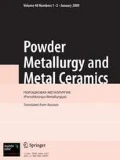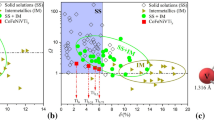To understand the unique mechanical properties of high-entropy alloys, it is important to know the nature and strength of interatomic interactions between similar and dissimilar atoms. In this regard, the objective of this study is to use the phenomenon of secondary ion emission for Cr14.3Mn14.3Fe14.3Ni28.6Co14.3Cu14.3 alloy with fcc structure. The yield of secondary ions for all alloy components and corresponding pure metals is quantitatively compared for the first time and an equation is proposed to calculate the atomic bond energy based on the existing models of secondary ion emission mechanism. Compared to pure metals, the bond energy increases in the alloy for Cr and Fe atoms. The greatest decrease in the bond energy is observed for Mn atoms. Reduction in the bond energy for Co and Ni is insignificant. It is suggested that the atomic interaction energy is influenced by changes in the local electron density in fusion as compared with pure metals.

Similar content being viewed by others
References
V. I. Veksler, Secondary Ion Emission of Metals [in Russian], Nauka, Moscow (1978), p. 240.
R. J.-B. Castaing, G. Slodzian, et al., “On possibilities of local analysis using secondary ion emission,” Acad. Sci. B, 251, 1010–1012 (1960).
Ya. M. Fogel’, “Secondary ion emission,” Usp. Fiz. Nauk, No. 1, 75–112 (1967).
V. T. Cherepin and M. A. Vasil’ev, Secondary Ion Emission of Metals and Alloys [in Russian], Naukova Dumka, Kyiv (1975), p. 239.
V. T. Cherepin and M. A. Vasil’ev, Methods and Tools for Surface Analysis of Materials [in Russian], Naukova Dumka, Kyiv (1982), p. 400.
V. T. Cherepin, Ion Microprobe Analysis [in Russian], Naukova Dumka, Kyiv (1981), p. 434.
J. Guepin, Contribution of Secondary Ion Emission: Theses [in French], Centre D’Orsay, Paris (1963), p. 65.
H. E. Beske, “Positive yield of secondary ions of 21 elements,” Z. Naturforschung, 4, 30–35 (1964).
G. Blaise and M. C. Cadeville, “Electronic structure of f.c.c. NiFe alloys, investigated by means of secondary ion emission,” J. Phys., 36, No. 6, 545–550 (1975).
F. Honda and J. W. Rabalais, “Quantitative surface analysis of copper–nickel alloys by secondary ion mass spectrometry,” Anal. Chem., 52, 2213–2214 (1980).
J.-F. Hennequin, R.-L. Inglebert, and P. V. de Lesegno, “Secondary ion and auger electron emission from Ar ion sputtered Fe–Al alloys,” Surf. Sci., 140, 197–201 (1984).
M. Abon and J. C. Bertolini, “Secondary ion emission of Rt–Ni single crystal alloys,” Appl. Surf. Sci., 32, 343–351 (1988).
J. W. Yeh, Y. L. Chen, S. J. Lin, and S. K. Chen, “High-entropy alloys––a new era of exploitation,” Mater. Sci. Forum, 560, 1–9 (2007).
Y. Zhang and Y. J. Zhou, “Solid solution formation criteria for high entropy alloys,” Mater. Sci. Forum, 561–565, 1337–1339 (2007).
S. A. Firstov, V. F. Gorban’, N. A. Krapivka, and É. P. Pechkovskii, “Strengthening and mechanical properties of cast high-entropy alloys,” Kompos. Nanomater., No. 2, 5–20 (2011).
S. A. Firstov, V. F. Gorban’, N. A. Krapivka, et al., “Effect of electron density on phase composition of high-entropy equiatomic alloys,” Powder Metall. Met. Ceram., 54, No. 9–10, 607–613 (2016).
C. Kittel, Introduction to Solid State Physics, 6th ed., Jonn Wiley, New York (1986), p. 646.
U. Bardi, F. Niccolaic, M. Tostic, and A. Tolstogouzov, “Gold assay with knudsen effusion mass spectrometry,” Int. J. Mass Spectrom., 273, 138–144 (2008).
P. Sigmund, “Theory of sputtering. I. Sputtering yield of amorphous and polycrystalline targets,” Phys. Rev., 184, 383–416 (1969).
J. M. Schroeer, T. N. Rhodin, and R. C. Bradley, “A quantum-mechanical model for the ionization of atoms during sputtering,” Surf. Sci., 34, 571–580 (1973).
W. H. Gries, “Quantum ion implantation: theoretical aspects,” Int. J. Mass Spectrom. Ion Phys., 17, 97–112 (1975).
M. V. Kuvakin, E. S. Kharlamochkin, and V. I. Bachurin, “Change in interatomic potential of interaction in gadolinium in magnetic phase transition,” Poverkhnost, No. 1, 89–92 (1982).
Yu. A. Bandurin, V. I. Bachurin, V. G. Drobnich, et al., “Ion-photon emission of cobalt in polymorphic transformation,” Pis’ma Zh. Tekh. Fiz., No. 12, 760–763 (1982).
V. V. Nemoshkalenko and V. G. Aleshin, Electron Spectroscopy of Crystals [in Russian], Naukova Dumka, Kyiv (1976), p. 179.
Author information
Authors and Affiliations
Corresponding author
Rights and permissions
About this article
Cite this article
Firstov, S.A., Krapivka, N.A., Vasiliev, M.A. et al. Secondary Ion Emission of High-Entropy Cr14.3Mn14.3Fe14.3Ni28.6Co14.3Cu14.3 Alloy. Powder Metall Met Ceram 55, 458–463 (2016). https://doi.org/10.1007/s11106-016-9827-7
Received:
Published:
Issue Date:
DOI: https://doi.org/10.1007/s11106-016-9827-7




